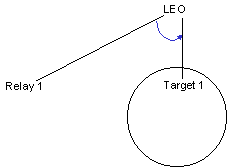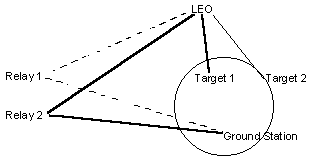Several specialized reports and graphs are available for a chain.
Several report and graph styles are valid only for chains with strands that contain two or three objects. For example, the Access AER, Access Data, and Event Data styles require a chain with strands that contain only two objects. In these instances, a constellation can serve as a single chain object.
Report and graph styles for chains include the following:
Angle Between
This report or graph calculates the angle between the relative position vectors along the chain path when there are three objects in a chain.
This report or graph is valid only for chains that contain exactly three objects. One or more of the objects can be a constellation.
The following diagram illustrates the Angle Between calculation:

Complete Chain Access
The Complete Chain Access report shows times during which access among all objects in a chain is possible through one or more strands. If the chain contains a constellation whose constraint is set to None Of, the report lists the times when there is no access among all objects in the chain.
Computed Strands
The Computed Strands report shows the number of valid strand and the truncated path names for all computed strand[s]. The Chain must be computed for this report to have any data.
Individual Object Access
Individual object access is the accumulated total of all strands that include the object in question.
The following diagram shows individual object access for the Relay1 satellite. Access is shown with bold lines:

Individual object access for Relay1 in this diagram would include access times for:
- Ground Station - Relay1 - LEO - Target1
- Ground Station - Relay1 - LEO - Target2
Use the scroll bars on the right side and on the bottom of the report window to view additional data. You can also click and drag the corner of the window to enlarge its size so that all data is displayed.
Individual Strand Access
A strand represents one possible access pathway through the chain. For a chain that consists of a series of individual objects, only a single strand is possible. If a chain contains one or more constellations, multiple strands are possible, but constellation constraints (ANY OF, ALL OF, AT LEAST N, EXACTLY N) can affect the possible number of strands.
The following diagram shows possible strand accesses from a ground station, via one of two relay satellites, followed by a LEO satellite, to one of two targets.

Individual strand access for Ground Station- Relay2 - LEO - Target1 is shown in bold:
Individual strand access for this example would include access times for:
- Ground Station - Relay1 - LEO -Target 1
- Ground Station - Relay2 - LEO - Target 1
- Ground Station - Relay1 - LEO - Target 2
- Ground Station - Relay2 - LEO - Target 2
Number of Accesses Graph
The Number of Accesses graph calculates the total number of accesses between two objects in a chain.
This graph is valid only for a chain that contains exactly two objects. One or more of the objects can be a constellation.
Optimal Strand Value
The Optimal Strand Value graph shows the computed metric value for the single best strand at all sample times. The Chain must be computed with the optimal path metric enabled for this report to have any data.
Optimal Strand at Time
The Optimal Strand at Time report shows the single best strand for all sample times and the value of the computed optimal metric for that strand. The Chain must be computed with the optimal path metric enabled for this report to have any data.
Optimal Strands by Time
The Optimal Strands by Time report shows the N best strands for each sample time with the value of the computed optimal metric for each strand. The Chain must be computed with the optimal path metric enabled for this report to have any data.
Valid Paths
The Valid Paths report shows the number of possible paths from the Start object to the End object using the connections to route from Start to End. Grouping objects are displayed the Valid Paths, they are not broken down into their contents. The Chain does not need to be computed for this report to return data.
Note on Chain Access AER
If you are exporting a Chain Access AER report, there are several ways to ensure that "to" and "from" objects are correctly identified in the exported data, including:
- Use the Strand Name element of the Chain Access AER data provider, which can be added as a column.
- When exporting, select Export -> Report -> Complete, which will put the subsection title, in this case the strand name, into the exported data.